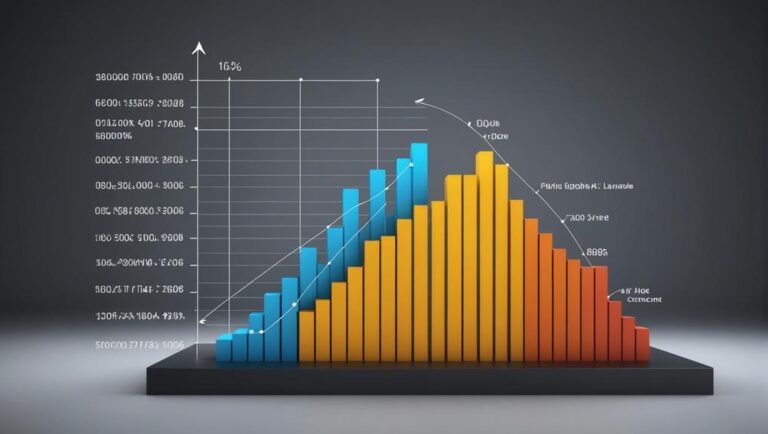Effective Tax Rate: How Its Calculated and How It Works
The crucial tax rate signifies the percentage of income allocated to taxes, crucial for financial analysis and planning. It aids in evaluating tax efficiency and overall tax burden, essential for individuals and corporations in maximizing after-tax income and making informed investment decisions. Contrasting the effective tax rate with the marginal tax rate provides insights into average tax burden and last dollar taxes, impacting strategic financial decisions. Understanding federal tax brackets and rate systems, along with various tax rate types, allows for accurate tax burden comparison, equitable tax distribution, and informed utilization of tax strategies and incentives. Discover more about effective tax rate intricacies to enhance financial management.
Key Takeaways
- Effective tax rate is calculated by dividing total taxes paid by taxable income.
- It provides an average percentage of income paid in taxes.
- Varied deductions and credits impact the effective rate.
- Helpful in evaluating overall tax burden and planning strategies.
- Crucial for understanding tax efficiency and making informed financial decisions.
Understanding Effective Tax Rate Calculation
The calculation of the effective tax rate is a fundamental aspect of financial analysis, providing a precise measure of the proportion of income that is allocated towards taxes by individuals or corporations.
Understanding effective tax rate calculation is important for tax planning strategies and investment implications. By accurately determining the ETR, individuals can strategize to minimize tax liabilities through deductions and credits.
For corporations, analyzing the ETR aids in evaluating tax efficiency and making informed financial decisions. Effective tax rate calculations play a pivotal role in evaluating the overall tax burden, guiding individuals and businesses towards effective tax strategies and investment planning.
It is an essential metric in detailed financial analysis, offering insights into the tax implications of income allocation and expenditure decisions.
Application in Individual and Corporate Taxes
Understanding the effective tax rate calculation serves as a fundamental tool for individuals and corporations to make informed decisions regarding tax planning strategies and investment implications, particularly in the context of applying it to individual and corporate taxes.
When considering individual taxes, the effective tax rate aids in evaluating the overall tax burden and guides tax planning strategies for maximizing after-tax income.
For corporations, this metric is vital in investment analysis, helping investors assess the profitability of companies.
By utilizing the effective tax rate, individuals and corporations can gain insights into their tax liabilities, optimize tax planning strategies, and make strategic investment decisions.
This analytical approach enables better financial decision-making and enhances overall fiscal management for both individuals and corporations.
Effective Vs. Marginal Tax Rate Differences
When comparing tax rates, the effective tax rate and marginal tax rate present distinct perspectives on an individual's or corporation's tax obligations. The effective tax rate reflects the average tax burden, considering all income levels and tax deductions, offering a thorough view of the overall tax liability.
In contrast, the marginal tax rate indicates the tax percentage paid on the last dollar earned, impacting decisions on additional income or deductions. The comparison between these rates illustrates how the effective tax rate provides a more precise portrayal of the total tax burden, often differing from the marginal rate due to the progressive nature of tax systems.
Understanding these differences is essential for tax planning and evaluating the true impact of tax obligations on financial decisions.
Federal Tax Brackets and Rate System
Analysis of the Federal Tax Brackets and Rate System reveals a structured framework established by the IRS based on income levels and filing statuses. The system encompasses tax bracket nuances, where individuals are taxed progressively as their income increases.
Understanding the rate comparison analysis within these brackets is important for taxpayers to comprehend how their income is taxed at different levels. Effective tax rates vary among individuals even within the same bracket due to deductions, credits, and other factors. This highlights the significance of accurate calculations to compare tax burdens effectively.
The graduated tax system employed by the IRS guarantees that taxpayers contribute proportionally to their earnings, reflecting a fair distribution of tax responsibilities across different income levels and filing statuses.
Insights Into Various Tax Rate Types
Exploring the complex world of taxation, an investigation of various tax rate types reveals the multifaceted landscape of financial obligations individuals and corporations encounter. Understanding progressive taxation is important in tax planning strategies. Progressive taxation means that as income rises, the percentage of that income paid in taxes also increases. This system aims to distribute the tax burden more equitably based on the taxpayer's ability to pay. By strategically utilizing tax planning strategies, individuals and businesses can take advantage of tax credits, deductions, and other incentives to minimize their tax liability. Effective tax planning not only guarantees compliance with legal requirements but also optimizes financial outcomes.
| Tax Rate Type | Description | Example |
|---|---|---|
| Marginal Tax | Applies different rates to different levels | Graduated tax system |
| Progressive Tax | Tax rate increases as income rises | Higher income individuals pay more taxes |
| Tax Planning | Strategies to minimize tax liabilities | Deductions, credits, deferrals |
Conclusion
To sum up, evaluating tax rate serves as a critical metric in gauging tax burdens for individuals and corporations. By comparing this rate to the statutory tax rate, discrepancies can be identified, shedding light on the intricacies of tax systems.
One interesting statistic to note is that the top 1% of income earners in the United States pay an average effective tax rate of 24.7%, highlighting the disparities in tax obligations across different income levels.







